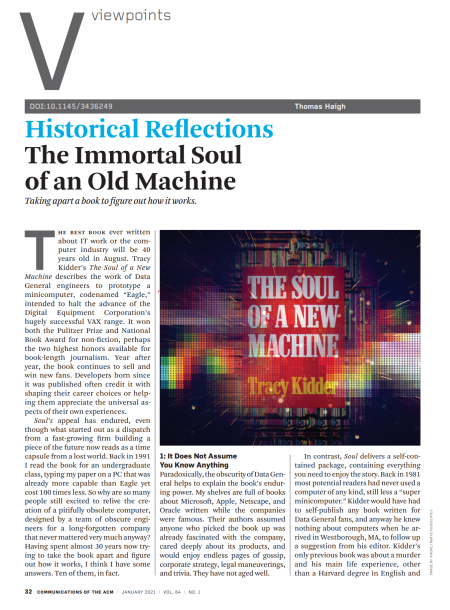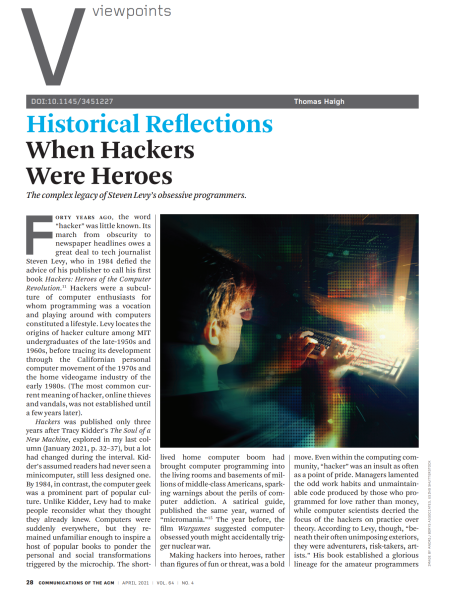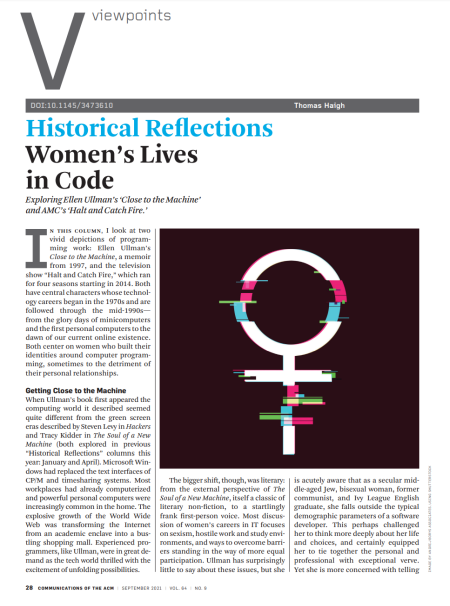Since 2011 I have written "Historical Reflections" columns for Communications of the ACM. That's a glossy publication that goes out on paper to around 65,000 members of the association, and in PDF form to its student members. Most years I publish two contributions, on a variety of topics from original research on von Neumann's attitudes towards the work of Alan Turing to an attack on Google's misappropriation of the term "moonshot." Rather than just tell stories about old computers, I try to give the computer science audience a feel for how historians think and what kinds of insight we can provide. The columns typically get between 10,000 and 20,000 downloads from the ACM Digital Library, so they are undoubtedly the most read things I have written.
I recently finished a series of three columns on classic depictions of IT work. This was originally supposed to be a quick and easy column, but as I started to write I realized I would need to spread the four things I wanted to write about over three columns.
 |
The first one, in the January 2021 issue, dealt with Tracy Kidder's book The Soul of a New Machine. While the upcoming 40th anniversary gave a topical excuse to write about the book, it was something I'd been thinking about for a long time. Back in England as a computer science student, an undergraduate essay I wrote on the book caught the attention of an American faculty member who urged me to apply for graduate school in the US. Once I got there two of the professors I studied with, Rob Kohler at Penn and Mike Mahoney at Princeton, assigned the book and repeatedly quoted from it. I knew from blog posts and Amazon reviews that many computer engineers and programmers credit the book with their own career choices or praise it for capturing elements of their own experiences. Yet I had never read anything that really dug into the book and tried to understand what Kidder had done to make it so captivating. |
| Steven Levy's Hackers was a book I discovered on the shelf in the Penn library, around 1997. I picked it up without high expectations, started reading, and was startled by how engaging and evocative Levy's writing was. In retrospect it's strange I hadn't come across it earlier. Perhaps the book was in a lull between its initial commercial success and the widespread uptake of Levy's "hacker ethic" as a description for the ethos of the much-studied free and open source software movement. Today the book is far from obscure, but still perhaps cited more than read. His bullet point ethic sums up so well the culture of the MIT hackers, the subject of the first of its three parts, that people often seem to overlook the rest of the book. Returning to it, I found the work as a whole stranger, richer, and more deeply routed in the 1980s than I had remembered. It also resonated in new ways with the Levy's own later work on Facebook and Google and with the disturbing mindset of the people running those all-powerful companies. |
 |
 |
For the final installment I examined two works: Ellen Ullman's mid-1990s memoir Close to the Machine and the recent AMC television series "Halt and Catch Fire." Though created decades apart, both deal with the same time period and tell stories about women's work with computers that go far beyond the usual inspirational stories about genius innovators. Ullman's memoir still seems to me the best description of programming work ever published, and I am fascinated by the way that she presents herself at once as an outlier in that world (female, Jewish, bisexual, Ivy League English graduate and former communist organizer) and as someone able to describe from the inside the experience of programming and the culture of computing. "Halt and Catch Fire" became one the great television shows of the last decade, but only after stumbling through a first season warped by immersion in the archetypal stories of male genius and the narrative template of Steve Jobs and Steve Wozniak. |


